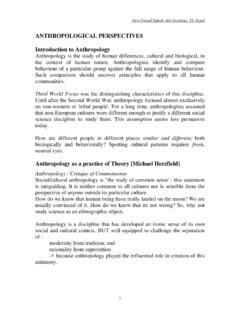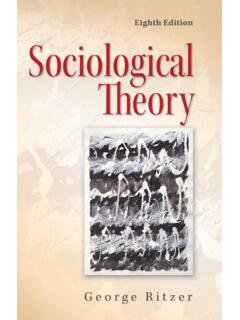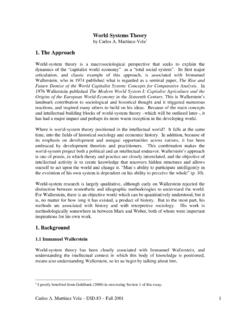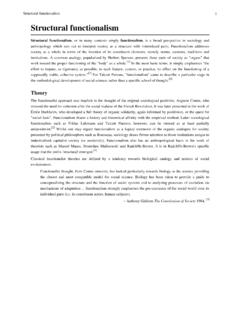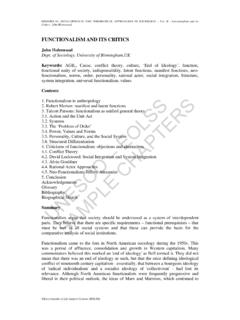Transcription of STRUCTURAL FUNCTIONAL PERSPECTIVE IN SOCIOLOGY
1 Devi Prasad Subedi, MA SOCIOLOGY , TU Nepal 1 STRUCTURAL FUNCTIONAL PERSPECTIVE IN SOCIOLOGY (CONFLICT THEORY ALTERNATIVE) STRUCTURAL Functionalism is a broad PERSPECTIVE in SOCIOLOGY and anthropology which interprets society as structure with interrelated parts. Functionalism addresses the society as a whole in terms of function of its constituent elements such as norms, customs, traditions, institutions etc. Social structures are stressed and placed at the center of analysis and social functions are deduced from these structures.
2 Functionalism is the oldest and dominant conceptual PERSPECTIVE in society. Functionalism has its roots in the organicism (Comte) of early 19th century. Organicism of Comte (and later that of Spencer and Durkheim) influenced the frunctional anthropologists Malinowski and Redcliffe Brown. Durkheim's timeless analysis and Weber's emphasis on social taxonomies (ideal types) began to shape modern/contemporary STRUCTURAL PERSPECTIVE .
3 2A. HISTORICAL CONTEXT Legacy of the early functionalist's work 1. Social world was viewed in systemic terms. The system had needs and requisites to be met to assure survival 2. Systems have normal and pathological states. Systems need system equilibrium and homeostasis. 3. As a system, the world is composed of mutually interrelated parts. Study of the parts focused on how they fulfilled the requisites of the systemic wholes and how they are maintained equilibrium. 4. Causal analysis became vague - lapsing into tautologies and illegitimate teleologies and illegitimate teleologies.
4 2B. KEY ARGUMENTS 2B1. Whole part and Systemic interrelationship Systems Theory is a framework of investigating any group of objects that work together to produce some result. This could be a single organism, any organization or society. A system is composed of regularly interacting and interrelating group of activities. It is a dynamic equilibrium model. There are often properties of the whole which cannot be found in the properties of the elements. In some cases behavior of the whole cannot be explained in terms of behavior of the parts.
5 Properties of these letters which when considered together can give rise to meaning which does not exist in letters by themselves. Pattern of integration and interrelation of elements/parts determines behavior of the system. integration of 'n' and 'o' may create 'on' or 'no'. All phenomena can be viewed as a web of relationships among elements/system. Devi Prasad Subedi, MA SOCIOLOGY , TU Nepal 2 A system can act as an element. 'an individual' acts as a system as integration of its organs and it can act as an elements of a group or society.
6 2B2 Consensus, Stability, order versus conflict, instability and change (Consensus and Conflict PERSPECTIVE ) Consensus PERSPECTIVE Consensus PERSPECTIVE sees equilibrium in the society only when there is absence of conflict. Widespread/general agreement among members of the particular society brings stability and order. This PERSPECTIVE focuses on maintenance and continuation of social order in society. (Interpretive SOCIOLOGY and STRUCTURAL functionalism) Structuralists proposed STRUCTURAL reading of marxism in the following way (macro PERSPECTIVE of society): - society consists of a hierarchy of structures distinct from one another.
7 - Conflict is naturally prevalent within social structures. People are the product of STRUCTURAL conflict. - Conflict emerges by itself because of incompatible relationships - therefore change will come. - Just like internal organs of a normal biological organism, society maintains its stability, order and progress only when social organs, structure and institutions coordinate and cooperate with each other (are in equilibrium) - NOT conflict with each other. - Society cannot operate for any length of time on the basis of force.
8 Society is held together by the consensus of its members. Conflict PERSPECTIVE This PERSPECTIVE emphasizes conflict in the society. It deals with the incompatible aspects of the society. (Radical Humanism and Radical Structuralism) - Change emerges from the crisis between human beings and their society. - Human beings have capacity to think and act against situations that are not satisfactory to their existence. - Means of conflict between two classes of people can bring change in society. 2B3. FUNCTIONAL Prerequisites/Imperatives Analysis of the things (functions) that a social system needs in order to survive: What needs to be avoided?
9 These factors threaten the existence of society, so, need to be avoided. o Extinction or dispersion of population o Highly apathetic population o War of "all against all" What needs to be adapted? Society should adapt the following characteristics: Devi Prasad Subedi, MA SOCIOLOGY , TU Nepal 3o society must have adequate methods of dealing with environment (ecology + social system) o society must have adequate method for sexual recruitment (couple must product something above 2 children) o must have sufficient number of people with diverse interest and skills o must have sufficient differential roles and assignment of people to those role (social stratification)
10 O Adequate communication system o Common/shared value pattern (at individual and group level) o Share articulated set of goals o Requires some method of regulating the means to achieve these goals (normative regulation of goals) o Society must regulate affective expressions (unnecessary emotions) - but some are quite necessary, love, family loyalty) o Socialization of new member o Effective control over disruptive forms of behavior Four Types of FUNCTIONAL Prerequisites (Merton) 1. The FUNCTIONAL Pattern Maintenance o maintaining the stability of pattern character of normative person state of institutionalization o STRUCTURAL category of values o motivational commitment/tension management (socialization mechanism) 2.
